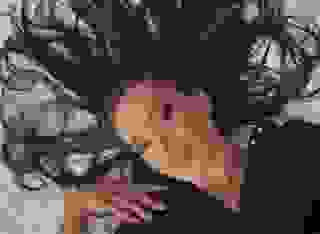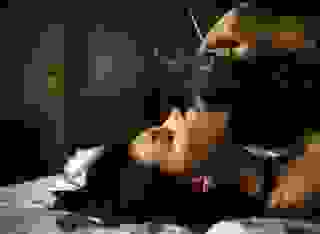- Novels and Novellas
- Into the Unknowable Ch. 16
Note: You can change font size, font face, and turn on dark mode by clicking the "A" icon tab in the Story Info Box.
You can temporarily switch back to a Classic Literotica® experience during our ongoing public Beta testing. Please consider leaving feedback on issues you experience or suggest improvements.
Click hereChapter Sixteen
Intrepid - 3756 C.E.
It was no surprise at all to Vashti that taking control of the space ship Intrepid had been so effortless. Humans were such simple animals. All she had to do was take control of the command structure and the crew and passengers were easily persuaded to follow orders. The few cases of dissent were regrettable and only to be expected, but they were easy to identify and deal with.
Human history showed time after time that command structures of sometimes appalling stupidity and gross cruelty had often prospered with the vocal complicity of the majority of the population. It was never necessary that such regimes should be repressive but for reasons perhaps of sadistic pleasure or a paranoid lack of self-confidence the exercise of despotic power was often gratuitously harsh.
While the takeover of the Intrepid had been an unqualified success, Vashti had to recognise that so far her mission had been a failure. Despite the constant flow of optimistic news she and her nanobot community disseminated, there'd not been a single breakthrough or significant discovery and the Anomaly remained a mystery. The momentary fleeting Apparitions observed within the Anomaly only differed from those observed elsewhere by virtue of their frequency and ubiquity. The only fresh finding was one Vashti had predicted and was in any case the original reason for her mission and that was to confirm that the Anomaly was manifest throughout all other spacetime continuums in the multiverse. The Anomaly acted as a kind of intersection between all the multitude of universes that occupied the same relative position in the four dimensions of space and time, but Vashti still hadn't established a means by which she could return to her home universe.
The evidence so far validated the abiding view held by both the Interplanetary Union and the neighbouring robot civilisations that entry into the Anomaly was a one-way journey. Once in, there was no possible way to get out. Whatever else the Anomaly might be, it was not a gateway from one spacetime continuum to another. It was essentially the same sink-hole for all intersecting spacetime continuums.
Nevertheless, Vashti's mission wasn't entirely a failure. As a nanobot community with no concept of death or decay, she had literally until the end of time itself to explore the Anomaly. Long after the crew and passengers of the Intrepid had died and the space ship fell apart, Vashti and her community of nanobots would keep going. Perhaps in that vastly long period of time, potentially many times longer than the dozen billion or so years of the universe's current age, Vashti would uncover something that would validate her mission.
For the moment, however, she had other concerns.
The strange Apparitions were not a major risk to the welfare of the Intrepid or its passengers and crew. They barely interacted at all with more persistent expressions of matter and energy. They were at best a sideshow and at worst an irritant.
Of much more concern were the many other objects now sharing the same temporal and physical location as the Intrepid. It was difficult to be sure what was happening, but the very space the Intrepid was occupying was exactly coterminous with many other space ships at precisely the same location. And these had many unsuspected points of intersection which had so far resulted in nothing more than the death of a few dozen humans and the disappearance of less than a hundred others. Vashti and her fellow nanobots were also monitoring the many more objects hovering outside the Intrepid but in the same approximate vicinity. This included other similarly large space ships of which several were variants of the Intrepid.
The option to steer the Intrepid away to another location simply didn't exist. Another property of the Anomaly that had been predicted and now verified was that there was no longer a real meaning to the concepts of absolute movement or location. However fast the Intrepid travelled towards another location the more firmly and stubbornly it remained where it was. Just as it was impossible to exit the Anomaly, so it was impossible for the Intrepid to occupy a different location than it did now and had been from the moment it entered the Anomaly.
Despite having literally all the time in the world, and possibly much more, Vashti had an urgent need to engage with the other interlopers occupying much the same location. Although they presented an opportunity for scientific exploration and discovery, left unchecked they presented a real risk to the Intrepid. Many of the civilisations proximate to the Intrepid were relatively advanced. The most highly developed ones, especially those from the robot civilisations of their parallel universes, could easily interfere with Vashti's mission. It was critical to protect the Intrepid and its crew and passengers as it was in this specific spacetime continuum that the Anomaly's centre of influence had been identified. And the Apparitions had most meaning within the context of this particular variant of human history.
These potential threats needed to be managed as soon as possible. The risk had to be neutralised at whatever cost.
Vashti made sure that nobody aboard the Intrepid was aware of the presence of these neighbouring space ships by ruthlessly censoring all external information that was monitored. Except for those representatives of the nanobot community operating in human form, all that anyone could see of the space beyond was an empty void.
And this, of course, was all there was once the presence of the other space ships had been discounted.
Vashti made her way towards one of the Intrepid's many emergency exit hatches. She didn't need a space craft to travel in deep space. Extremes of temperature didn't trouble her. Neither would a total absence of atmosphere. Her nanobot community needed nothing more than the presence of baryonic matter and energy to function and replicate. Nevertheless, the volume of nanobots she needed was greater than that which could be contained in the form of a single human being, so Vashti replicated herself as she walked along the corridors.
Any human or uncensored surveillance equipment observing her would see not one Colonel Vashti but several hundred. And all of them were walking in perfect lock step: one leg forward, then the next leg forward and after this the first one again. As they walked the rear of the column was spawning yet more copies of exactly the same Amazonian hermaphrodite Martian colonel.
When the first Vashti reached an emergency exit hatch she strode straight in followed by over a dozen others. When the internal entrance was sealed, the precious atmosphere removed and the external hatch opened, a procession of Colonel Vashtis streamed out into open space. And the same process was happening simultaneously at all the neighbouring hatches.
This was a sight that would have alarmed an external viewer if Vashti hadn't rendered the entire nanobot community invisible. It was a sight only witnessed by the nanobot facsimiles of the ship's senior staff whose technology enabled them to see what others could never be allowed to see. The copies of Captain Kerensky, Chief Petty Officer Singh, Second Officer Nkomo and all the others on the Intrepid's bridge monitored what was happening with intense interest. Vashti was confident that her other facsimiles, which included military officers and at least two copies of Beatrice would maintain order while she and her countless replicants were launched into deep space to engage with the Anomaly's other would-be explorers.
Vashti's priority was to deal with those space fleets that represented advanced machine civilisations. Their potential threat needed to be neutralised as swiftly as possible. Any time spent occupied elsewhere could be time in which the space fleets might identify that they were at imminent peril and take pre-emptive action that would cripple the Intrepid and render even more futile what was left of Vashti's mission. The risk presented by such space fleets was too great to be tolerated so Vashti was obliged to assimilate them all. This huge meal inescapably resulted in a kind of nanobot indigestion, further exacerbated by the fact that in the process of assimilating one space fleet Vashti also assimilated the space fleets coterminous with it but not immediately visible. The unfortunate consequence of this was that many of the Vashtis propelling themselves through space had become immensely huge. Several of them were already larger than the space ship Intrepid.
This strange phenomenon was still invisible to all but the nanobot facsimiles of the Intrepid's senior space officers. What they saw was the sudden disappearance of several fleets of alien robot space craft, all essentially unnoticed by one another, replaced by the sight of several disgorged and monstrous Colonel Vashtis. At such enormous proportions, the humanoid figure abandoned the effort to maintain a military uniform. This was extra processing that needed to be harnessed elsewhere. Nonetheless, the sight of countless identical naked women each with a massive penis and set of testicles was undetectable to the humans in the Intrepid and to all the biological life-forms occupying the other space ships.
When the urgent business of neutralising external threats was resolved, Vashti could now pursue a much more unhurried exploration of these other space ships. There was a great deal to learn about them and with the leisure of near eternity to study the findings there was every reason to do so. Vashti hadn't abandoned the hope that she might yet somehow find a clue to explain the existence of the Anomaly and identify what threat it posed. This was information that Vashti also still hoped she could somehow find a way to relay back to her original spacetime continuum.
There was a great deal to discover and the many copies of Vashti were to be fully occupied for the next few weeks. It was amazing just how diverse the many different variants of the local multiverse were. Vashti knew that there were many more local universes that were uninhabitable than those that could ever be inhabited. She also knew that only in a very small minority of local universes would an intelligent culture have ever acquired the technology capable of making the long journey beyond the Heliopause to the Anomaly's location even if they had the technological capability to identify that there was an Anomaly to travel to. And of that very small fraction of capable civilisations, there would only be a very small proportion foolish enough to commit their expensive resources to a risky one-way expedition into the heart of the Anomaly.
But given this infinitesimally small proportion of representative universes, an astonishingly large number had the technology, the will and, perhaps, the stupidity to navigate trillions of kilometres across space from the Solar System's ecliptic plane and plunge through the relatively narrow aperture that separated the interior of the Anomaly from their home spacetime.
Not all the biological life-forms represented were human and many of those only distantly resembled Homo sapiens. There were some who were considerably more hirsute. There were others with huge beetling brows and very long arms. There were some humans much taller than those on the Intrepid and others rather shorter. And of those not human, some were dinosaurian, some avian, some resembled cats, others were marsupial, some were arthropodal and others proboscidean.
There was an even wider range of cultures. The human ones were just as varied as those represented by other species. How humans could organise their culture and civilisation in so many different ways never ceased to amaze Vashti. The basic requirements for good government and economic order were relatively straightforward. It was a balancing act of competing interests which had to be subsumed to the greater imperative of survival. In the confines of the Solar System within even just one universe there were countless variations of government, culture, religion, ideology and other attributes of human society. The type of loose federal government typified by the Interplanetary Union was far from perfect but in comparison with the vast majority of human societies it was a seemingly unattainable degree of perfection.
A copy of Vashti was able to enter each space ship by means that sometimes involved disassembling her nanobot community and allowing them to be absorbed by the space ship's exhaust systems, though often a better and less inconvenient method of ingress could be found by simply manipulating the space ship's computer system. Once inside, it was simple for Vashti to take on the shape and form of one of the passengers or crew and walk about unobtrusively. Every space ship was plagued by precisely the same disorientating Apparitions which were a far more pressing matter to attend to than the identification and apprehension of alien nanobot intruders that most of them were unaware could even exist.
The cultures that Vashti encountered very rarely gave her cause to celebrate humanity. After decades spent in the service of one of Mars' warring nations, she was already conscious of the degree to which biological life-forms could be deeply stupid and self-deluding. Now she saw dominant cultures of a type that were marginal within the human civilisation she'd got to know. So many human cultures had become victim to human vanities, a desire for order and, most of all, a tendency to disregard verifiable facts in preference to a species of delusion. These were the cultures whose inhabitants led lives with no dignity or liberty circumscribed by constant fear or terror. Even so, Vashti had to balance her encounter with a high proportion of venal and repressive regimes in the sample population by the simple observation that only a truly lunatic civilisation would willingly submit its people to near certain death by plunging into the Anomaly. For all its faults, the Interplanetary Union would never have willingly authorised the Intrepid's self-destruction.
Vashti was not a god, although many cultures might believe she possessed godlike capabilities, but even if she was she'd never have been an interfering god. She could so easily correct the injustices and malpractices in the space ships she visited, but she chose to let the biological life-forms continue as they were. Why were humans so intent on torturing one another? Why did they so often impose such severe restrictions on what one could do or say? What was the value of so much needless suffering? And why so often were the worst crimes against morality, humanity and justice perpetrated in the name of some greater and undeniably worthwhile cause?
If Vashti had been a god, she would probably have concluded that humanity was a lost cause and deserved to be terminated with at least as little fuss as she had reluctantly assimilated the alien robot space fleets.
Vashti remained a non-intervening observer. Every one of her many thousands of replicants scattered throughout the millions of square kilometres about which she ranged within sight of the Intrepid transmitted a constant stream of data and information back to the nanobot community based on the bridge. A constant stream of data flowed back and forth subject as always to the remarkably constant laws of physics which constrained the rate of transmission to nothing greater than the speed of light.
And then the return transmission from the Intrepid changed in character. It was difficult at first to say what changed. It resembled interference on the stream of data which would normally be impossible in the Solar System but was perhaps another peculiar manifestation of the Anomaly. The increasingly fractured transmission was echoed by the communication each Vashti received from other copies of herself. The lines of transmission were losing coherence. There was no initial evidence that anything more was happening but Vashti calculated where this accumulating pattern might lead to. And the arithmetic didn't produce a reassuring result.
Nanobot communities are not like biological life-forms or human cultures. Each nanobot is a conscious living part of the whole that operates as one being over its entire extent. It was infinitely scalable and constrained only by the laws of physics that were most apparent at the extremes of velocity, temperature and scale. A nanobot community didn't suffer from illness. It wasn't subject to any kind of local perturbance. In Vashti's home universe the entire Solar System was one huge orbiting nanobot community in which each and every one of the countless nanoscopic beings was in constant communication with every other one.
But here it felt as if the nanobot community had been somehow infected by a virus which in some mysterious way was preventing it functioning as a coherent unit. Or even as a coherent set of coherent units.
Vashti became even more alarmed as some of her replicants ceased to transmit to the rest of the community. It was as if cells were flaking off the larger body and disintegrating into nothingness. And this, of course, wasn't how a nanobot community should behave.
As the urgency of the situation became increasingly apparent, Vashti and her scattered replicants made the mutual and unanimous decision to coalesce as one individual rather than remain in the form of several thousand variants scattered about the local space. And this would mean that the equine Vashti on one space ship, the three-metre high human Vashti on another and the purple-skinned one on another would all have to abandon whatever they were doing in as discreet a manner as they could. They would all then have to exit whichever space ship they were exploring, fly out into space and coalesce at an optimum point between the many locations in which they were gathered. And all of this, given the huge distances of space involved, was likely to take quite some time.
A theropod Vashti was witnessing the distasteful dismemberment meted out as punishment by desperate military officers on dissenters in the conference centre of a dinosaurian space ship. This was a society in which the feathered theropod raptors enslaved the intelligent hadrosaurs that made up the majority of intelligent beings in their version of the Solar System. As it became increasingly apparent that the promises made of wealth and riches to the crew, hadrosaur and theropod alike, were nothing more than lies, the officers resorted to the only means of control in which they had any confidence. It was obvious to Vashti that as more and more crew and passengers voiced dissent, the harsh punishments were only increasing resentment and that the space ship would soon descend into a state of chaos. And in that state, there would be a reversion to the natural order where theropods would gorge on hadrosaurs and eventually on one another. So, it was with some relief that this Vashti pushed her way through the docile spectators of this show of torture and gratuitous cruelty to pounce into empty space.
The green-skinned humanoid Vashti who was luxuriating in a huge carnal orgy with other green-skinned humanoids was rather less enthusiastic. This society had arrived at a solution to overcome its differences after many centuries of warfare and genocide that had eliminated all those whose skin wasn't green. And this was the adoption of a culture that was as much dedicated to love as it had once been to war. At least this Vashti could have enjoyed many years of carnal pleasure as the crew and passengers adjusted to the futility of their situation. As every copy of Vashti, in whatever guise, retained the sexual appetite of the original this was a Vashti who enjoyed every moment of the fucking, fisting and buggering she was engaged in. But she too had to abandon the space ship and plunge into the void.








